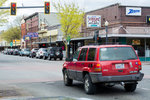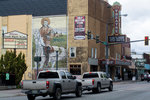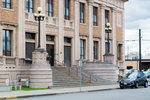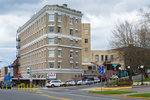




An interactive database launched last month using data from multiple Washington state departments lists more than a dozen publicly-owned buildings in Lewis and South Thurston counties that could be particularly unsafe during a major earthquake.
Governmental buildings in Centralia, Chehalis and Tenino appear on the Washington URM — Unreinforced Masonry — Dashboard, along with more than 30 privately-owned buildings that serve as hubs of activity from Pe Ell to Packwood. Residential addresses are also listed.
Unreinforced masonry in a structural sense is when a load-bearing brick wall is not supported by steel or another heavy-duty material, thus making it susceptible to collapse under the swaying duress of an earthquake.
Notable public buildings mapped in the database include Centralia City Hall, the Chehalis Post Office and the Lewis County Historic Courthouse. The Olympic Club, Chehalis Theater, Roxy Theater and Tenino Masonic Lodge are among the private hotspots on the map, which can be found at http://www.gartrellgroup.net/WashURMViewer.
“We live with it every day, but we don’t think about it every day,” said Steve Mansfield, Emergency Management Director for Lewis County. “The way I’ve always dealt with it is that I know the threat exists, and I try to take advantage of it to get people to think about it and prepare. I don’t want it to control people’s lives to the point of it being counterproductive, but it’s a risk we deal with in the Pacific Northwest that something could happen to impact our health, safety and welfare.”
Nearly every location in the database outside of Seattle, which curates a detailed roster of URM buildings, is given a tag of “suspected URM” or “unknown” based on data culled from the Department of Archaeology and Historic Preservation, the Washington Information System for Architectural and Archaeological Records Data and local sources such as county assessors.
Brick buildings built more than 50 years ago and not in use as single-family residences are suspected to be unreinforced, though it’s possible some may no longer be in use or may have received structural updates via renovations or seismic retrofitting.
Penny Thomas, media relations manager for the state Department of Commerce, said the report has received a positive reaction from public bodies and that her department would like to see the data used along with other tools down the road.
“Our study took into account only existing and readily available data,” Thomas said. “We know that wound up being a shortcoming due to score and budget limitations of the proviso that authorized Commerce’s work. Anything that can be done to update or enhance the quality and quantity of local data will ultimately serve to strengthen statewide data aggregation efforts in the future.”
The cost of retrofitting a residence can be as much as $10,000, with the work required for commercial buildings sometimes well into six figures. A structural analysis of the Chehalis Fire Station completed last year found the cost to retrofit the 90-year-old building would likely cost more than building a new facility.
Tenino City Hall could soon be in line for significant renovations, pending a $515,000 request for state funds from the 2019-2021 capital budget. It is unclear if those renovations would include seismic retrofits — Mayor Wayne Fournier did not return a call seeking comment prior to press time.
Those who live and work in buildings listed in the database should have a plan in place for a major earthquake, such as the potential for a 9.0 magnitude event along the Cascadia subduction zone. Information for how to stock emergency kits and prepare for a major rupture along the fault, given anywhere from a 10-20 percent chance of occurring in the next 50 years by seismologists, can be found online or at offices of local government.
Mansfield considers the children of Lewis County to be among the best prepared members of the community, because schools hold earthquake and fire drills far more often than places of business.
He recalled learning in the first grade how to drop to the floor, cover himself by getting under a desk and hold on.
That lesson came in handy the next year when an earthquake shook the school building.
“I think it’s almost a civic duty of everyone to think about what we’d do if something happened and how we would react,” Mansfield said. “There’s nothing we can do if a 9.0 (magnitude earthquake) hits. Some things are going to come down, and I don’t know what those will be, but saying, ‘I’m just going to roll the dice that it won’t happen in my lifetime,’ that is unacceptable to me.”